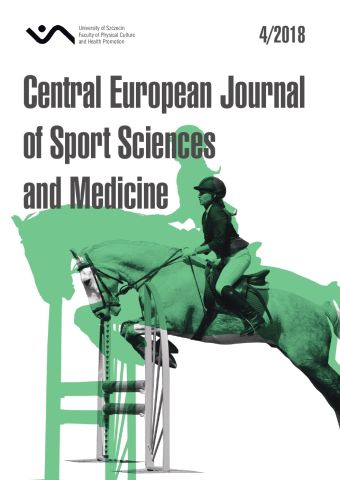
ISSN: 2300-9705
eISSN: 2353-2807
OAI
DOI: 10.18276/cej.2018.4-06




Lista wydań /
Vol. 24, No. 4/2018
Reliability of fitness trackers at different prices for measuring steps and heart rate: a pilot study
| Autorzy: |
Kayla
Ricchio
Department of Health, Exercise Science and Sport Management. University of Wisconsin - Parkside, Kenosha, United States Penny Lyter-Antonneau Department of Health, Exercise Science and Sport Management. University of Wisconsin - Parkside, Kenosha, United States José M. Palao 
Department of Health, Exercise Science and Sport Management. University of Wisconsin - Parkside, Kenosha, United States |
| Słowa kluczowe: | technology assessment physical activity exercise. |
| Data publikacji całości: | 2018-12-30 |
| Liczba stron: | 8 (57-64) |
Abstrakt
The purpose of this pilot study was to assess the accuracy of steps and heart rate measurement of wrist fitness
trackers at different prices. Four healthy college students voluntarily tested three wrist fitness bands and a sports watch (Xiaomi
Mi Band, Fitbit Charge HRm, Fitbit Surge, and sports watch Polar M400). Subjects performed two sets of 10 series of 100 steps
wearing the fitness trackers on an indoor track in two situations: walking and jogging. In the walking situation, the subjects wore
a winter coat and gloves. The variables measured were the number of steps, the heart rate, and the level of error. The steps error
percentage for all four devices was lower than 8%. The Fitbit Surge registered significantly more steps in the walking situation
(p < 0.001). No significant differences were found in the steps measurements in the jogging situation (p = 0.138). In the jogging
situation, significantly lower values in the heart rate measurements for the Xiaomi Mi Band, Fitbit Charger HR, and Fitbit Surge
were found (p < 0.001). The results showed that the wearable fitness trackers were relatively accurate for tracking steps (on
average, there was a level of error of 2–6%). The assessment of the steps was more accurate in the jogging situation (higher and
faster arm swing) than in the walking situation, which involved wearing coats and gloves. The results showed that the wearable
fitness trackers that were tested underestimate the heart rate with a level of error of approximately 6–11%. The step error was
lower in the walking situation (less mobility of the devices). The price of the devices that were tested did not affect the accuracy
of the steps and heart rate assessment. Further studies with a larger sample and more type of devices are needed to confirm
these results.
Pobierz plik
Plik artykułu
Bibliografia
| 1. | Brazeau, A.S., Beaudoin, N., Bélisle, V., Messier, V., Karelis, A.D., Rabasa-Lhoret, R. (2016). Validation and reliability of two activity monitors for energy expenditure assessment. Journal of Science and Medicine in Sport, 19(1), 46-50. |
| 2. | El-Amrawy, F., Nounou, M.I. (2015). Are currently available wearable devices for activity tracking and heart rate monitoring accurate, precise, and medically beneficial? Healthcare Informatics Research, 21(4), 315-320. |
| 3. | Evenson, K.R., Goto, M.M., Furberg, R.D. (2015). Systematic review of the validity and reliability of consumer-wearable activity trackers. International Journal of Behavioral Nutrition and Physical Activity, 12(1), 159. |
| 4. | Kooiman, T.J., Dontje, M.L., Sprenger, S.R., Krijnen, W.P., van der Schans, C.P., de Groot, M. (2015). Reliability and validity of ten consumer activity trackers. BMC Sports Science, Medicine and Rehabilitation, 7(1), 24. |
| 5. | Kroll, R.R., Boyd, J.G., Maslove, D.M. (2016). Accuracy of a wrist-worn wearable device for monitoring heart rates in hospital inpatients: a prospective observational study. Journal of Medical Internet Research, 18(9). |
| 6. | Montoye, A.H., Tuttle, M.S., Nelson, M.B., Steeves, J.A., Kaminsky, L.A. (2016). Abstract P121: Consumer-based physical activity monitors and research-grade accelerometers underestimate physical activity in a semi-structured setting. Circulation, 133(Suppl 1), AP121-AP121. |
| 7. | Murakami, H., Kawakami, R., Nakae, S., Nakata, Y., Ishikawa-Takata, K., Tanaka, S., Miyachi, M. (2016). Accuracy of wearable devices for estimating total energy expenditure: comparison with metabolic chamber and doubly labeled water method. JAMA Internal Medicine, 176(5), 702-703. |
| 8. | Nelson, M.B., Kaminsky, L.A., Dickin, D.C., Montoye, A.H. (2016). Validity of consumer-based physical activity monitors for specific activity types. Medicine & Science in Sports & Exercise, 48(8), 1619-1628. |
| 9. | Nunan, D., Donovan, G., Jakovljevic, D.G., Hodges, L.D., Sandercock, G.R., Brodie, D.A. (2009). Validity and reliability of short-term heart-rate variability from the Polar S810. Medicine & Science in Sports & Exercise, 41(1), 243-250. |
| 10. | Sasaki, J.E., Hickey, A., Mavilia, M., Tedesco, J., John, D., Kozey Keadle, S., Freedson, P.S. (2014). Validation of the Fitbit Wireless Activity Tracker® for Prediction of Energy Expenditure. Journal of Physical Activity and Health, 12, 149-154. |
| 11. | Shcherbina, A., Mattsson, C.M., Waggott, D., Salisbury, H., Christle, J.W., Hastie, T., Wheeler, M.T., Ashley, E.A. (2017). Accuracy in wrist-worn, sensor-based measurements of heart rate and energy expenditure in a diverse cohort. Journal of Personalized Medicine, 7(2), 3. |
| 12. | Terbizan, D.J., Dolezal, B.A., Albano, C. (2002). Validity of seven commercially available heart rate monitors. Measurement in Physical Education and Exercise Science, 6(4), 243-247. |
| 13. | Trochim, W. M., Donnelly, J. P. (2001). Research methods knowledge base (2nd edition). Retrieved from http://www.socialresearchmethods.net/kb/index.php. |
| 14. | Warburton, D.E.R., Jamnik, V.K., Bredin, S.S.D., Gledhill, N. (2011). The physical activity readiness questionnaire for everyone (PAR-Q+) and electronic physical activity readiness medical examination (ePARmed-X+). Health & Fitness Journal of Canada 4(2), 3-23. |